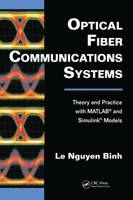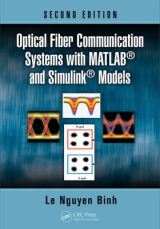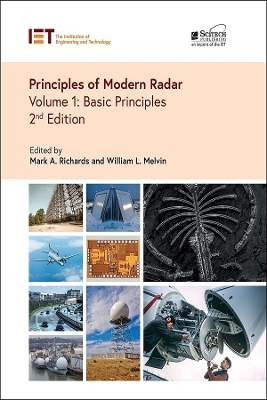
Optical Fiber Communications Systems
Crc Press Inc (Verlag)
978-1-4398-0620-3 (ISBN)
- Titel erscheint in neuer Auflage
- Artikel merken
Carefully structured to provide practical knowledge on fundamental issues, Optical Fiber Communications Systems: Theory and Practice with MATLAB® and Simulink® Models explores advanced modulation and transmission techniques of lightwave communication systems. With coverage ranging from fundamental to modern aspects, the text presents optical communication techniques and applications, employing single mode optical fibers as the transmission medium. With MATLAB and Simulink models that illustrate methods, it supplies a deeper understanding of future development of optical systems and networks.
The book begins with an overview of the development of optical fiber communications technology over the last three decades of the 20th century. It describes the optical transmitters for direct and external modulation technique and discusses the detection of optical signals under direct coherent and incoherent reception. The author also covers lumped Er:doped and distributed Roman optical amplifiers with extensive models for the amplification of signals and structuring the amplifiers on the Simulink platform. He outlines a design strategy for optically amplified transmission systems coupled with MATLAB Simulink models, including dispersion and attenuation budget methodology and simulation techniques. The book concludes with coverage of advanced modulation formats for long haul optical fiber transmission systems with accompanied Simulink models.
Although many books have been written on this topic over the last two decades, most of them present only the theory and practice of devices and subsystems of the optical fiber communications systems in the fields, but do not illustrate any computer models to represent the true practical aspects of engineering practice. This book fills the need for a text that emphasizes practical computing models that shed light on the behavior and dynamics of the devices.
Monash University, Clayton, Victoria, Australia
Introduction
Historical Perspectives
Digital Modulation for Advanced Optical Transmission Systems
Demodulation Techniques
MATLAB® and Simulink® Platforms
Organization of the Chapters in This Book
Optical Waveguides: Geometrical and Lightwave-Guiding Properties
IntroductionDielectric Slab Optical Waveguides
Optical Fiber: General Properties
Power Distribution
Nonlinear Optical Effects
Optical Fiber Manufacturing and Cabling
Concluding Remarks
Problems
Appendix: Technical Data of Single-Mode Optical Fibers
References
Optical Fibers: Signal Attenuation and Dispersion
Introduction
Signal Attenuation in Optical Fibers
Signal Distortion in Optical Fibers
Transfer Function of Single-Mode Fibers
Advanced Optical Fibers: Dispersion-Shifted, Dispersion-Flattened, and Dispersion-Compensated
Effects of Mode Hopping
Numerical Solution: Split-Step Fourier Method
Concluding Remarks
Problems
Appendix 3.A.1: MATLAB® Program of the Design of Optical Fibers—A Solution to the Mini-Project Design
Appendix 3.A.2: Program Listings of the Design of Standard Single-Mode Fibers
Appendix 3.A.3: Program Listings of the Design of Nonzero Dispersion-Shifted Fibers
Appendix 3.A.4: Program Listings of the Split-Step Fourier Method with SPM and Raman Gain Distribution
Appendix 3.A.5: Program Listings of the Initialization File
References
Overview of Modeling Techniques for Optical Transmission Systems Using MATLAB® and Simulink®
Overview
Optical Transmitter
Impairments of Optical Fiber
Modeling of Fiber Propagation
Optical Amplifiers
Performance Evaluation
MATLAB® and Simulink® Modeling Platforms
Concluding Remarks
References
Optical Modulation
Introduction
Direct Modulation
External Modulation Using Optical Modulators
Bias Control
Concluding Remarks
Appendix: MATLAB® Program for Solving the Laser Rate Equation
References
Optical Transmitters for Advanced Modulation Format
Introduction
External Modulation and Advanced Modulation Formats
Generation of Modulation Formats
Concluding Remarks
Problems
Appendix: Structures of Mach–Zehnder Modulator
References
Direct Detection Optical Receivers
Introduction
Optical Receivers in Various Systems
Receiver Components
Detection and Noises
Performance Calculations for Binary Digital Optical Systems
HEMT-Matched Noise Network Preamplifier
Concluding Remarks
Problems
Appendix: Noise Equations
References
Optical Coherent Detection
Introduction
Coherent Receiver Components
Coherent Detection
Self-Coherent Detection and Electronic DSP
Digital Signal Processing Coherent Optical Receiver
Coherent Receiver Analysis
MATLAB® and Simulink® Models
Concluding Remarks
Problems
Appendix: π/2 Hybrid Coupler Embedded MATLAB® Code
References
Erbium-Doped Fiber Optical Amplifi ers and Simulink® Models
Introduction
Fundamental and Theoretical Issues of EDFAs
EDFA Simulation Model
Concluding Remarks
References
MATLAB® and Simulink® Modeling of Raman Amplifi cation and Integration in Fiber Transmission Systems
Introduction
ROA versus Erbium-Doped Fiber Amplifiers
Raman Amplification
Nonlinear Raman Gain/Scattering Schrödinger Equation
Raman Amplifi cation and Gaussian Pulse Propagation
Optically Amplifi ed Transmission
Concluding Remarks
Problems
Appendix: Raman Amplifi cation and Split-Step Fourier Method—MATLAB® Program References
Design of Optical Communication Systems and Simulink® Models
Introduction
Long-Haul Optical Transmission Systems
Link Budget Calculations under Linear and Nonlinear Effects
Problems
Simulink® Models of Optically Amplified Digital Transmission Systems
ASK Modulation Formats Transmission Models
Return-to-Zero Optical Pulses
Differential Phase Shift Keying
Simulink® Models
DQPSK Modulation Formats Transmission Models
Spectral Characteristics of Advanced Modulation Formats
Partial Responses Duo-Binary Transmission Model
MSK Transmission Model
Star-QAM Transmission Systems for 100 Gb/s Capacity
Concluding Remarks
Appendix 12.A: Simulink® and Simulation Guidelines
References
Appendix: A Short Glossary of Terms in Optical Fiber Communications
Index
| Erscheint lt. Verlag | 26.4.2010 |
|---|---|
| Reihe/Serie | Optics and Photonics |
| Zusatzinfo | approx 481; 38 Tables, black and white; 417 Illustrations, black and white |
| Verlagsort | Bosa Roca |
| Sprache | englisch |
| Maße | 178 x 254 mm |
| Gewicht | 1157 g |
| Themenwelt | Technik ► Nachrichtentechnik |
| ISBN-10 | 1-4398-0620-9 / 1439806209 |
| ISBN-13 | 978-1-4398-0620-3 / 9781439806203 |
| Zustand | Neuware |
| Haben Sie eine Frage zum Produkt? |
aus dem Bereich



